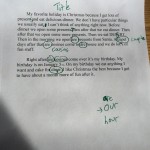Interviewer: How much rewriting do you do?
Hemingway: It depends. I rewrote the ending of Farewell to Arms, the last page of it, 39 times before I was satisfied.
Interviewer: Was there some technical problem there? What was it that had stumped you?
Hemingway: Getting the words right.
— Ernest Hemingway, The Paris Review Interview, 1956
The first mention of “editing and revising” in 4th and 5th grade writing this year brought a lot of cringes, sighs, and cries of horror. Our writers have high degrees of choice and flexibility in what they write, so mandated revision was understandably greeted with distaste. But that disgust has melted into enthusiasm – or at least understanding acceptance – as the year has progressed. The pristine sight of an edited, revised, finalized piece gives immediately positive reinforcement for a writer. Sharing that piece – in our writer’s workshop, on the bookshelf in our classroom, hung on the walls outside of it, with family at home, at Portfolio Night, or on the Bixby Writers Blog – further reinforces the satisfaction of revision.

“By the time I am nearing the end of a story, the first part will have been reread and altered and corrected at least one hundred and fifty times. I am suspicious of both facility and speed. Good writing is essentially rewriting. I am positive of this.” — Roald Dahl




